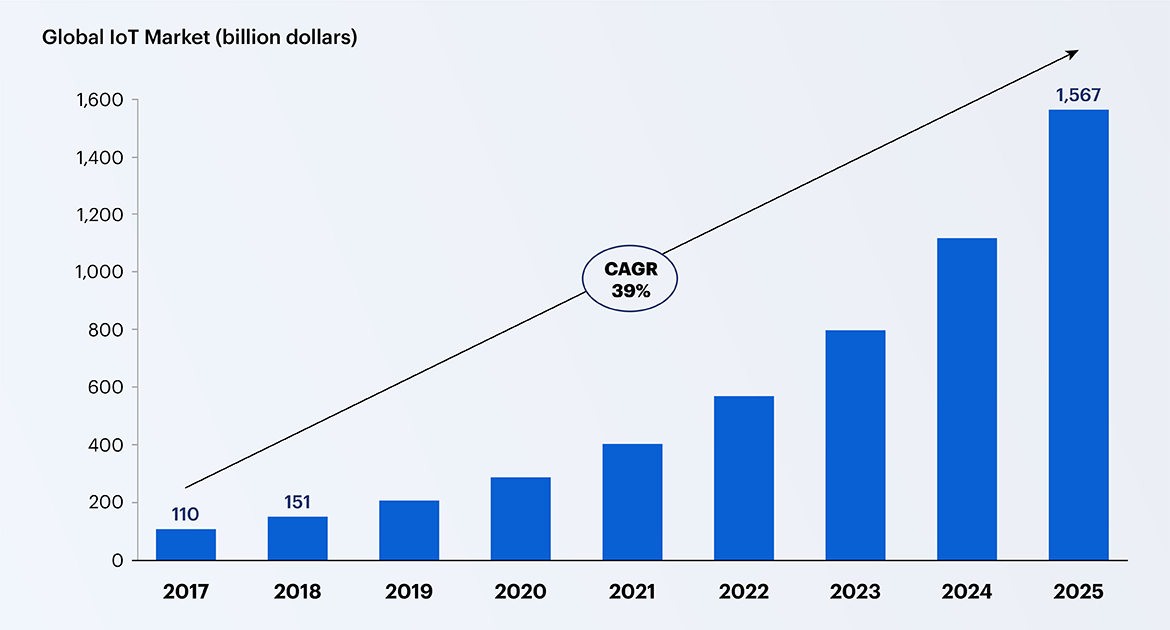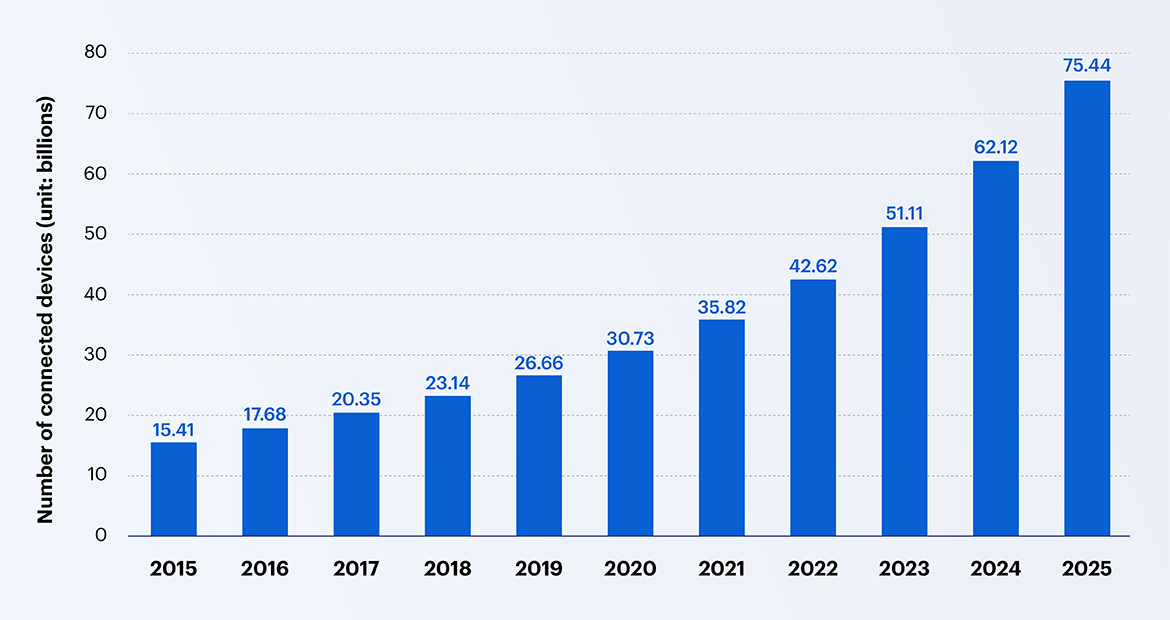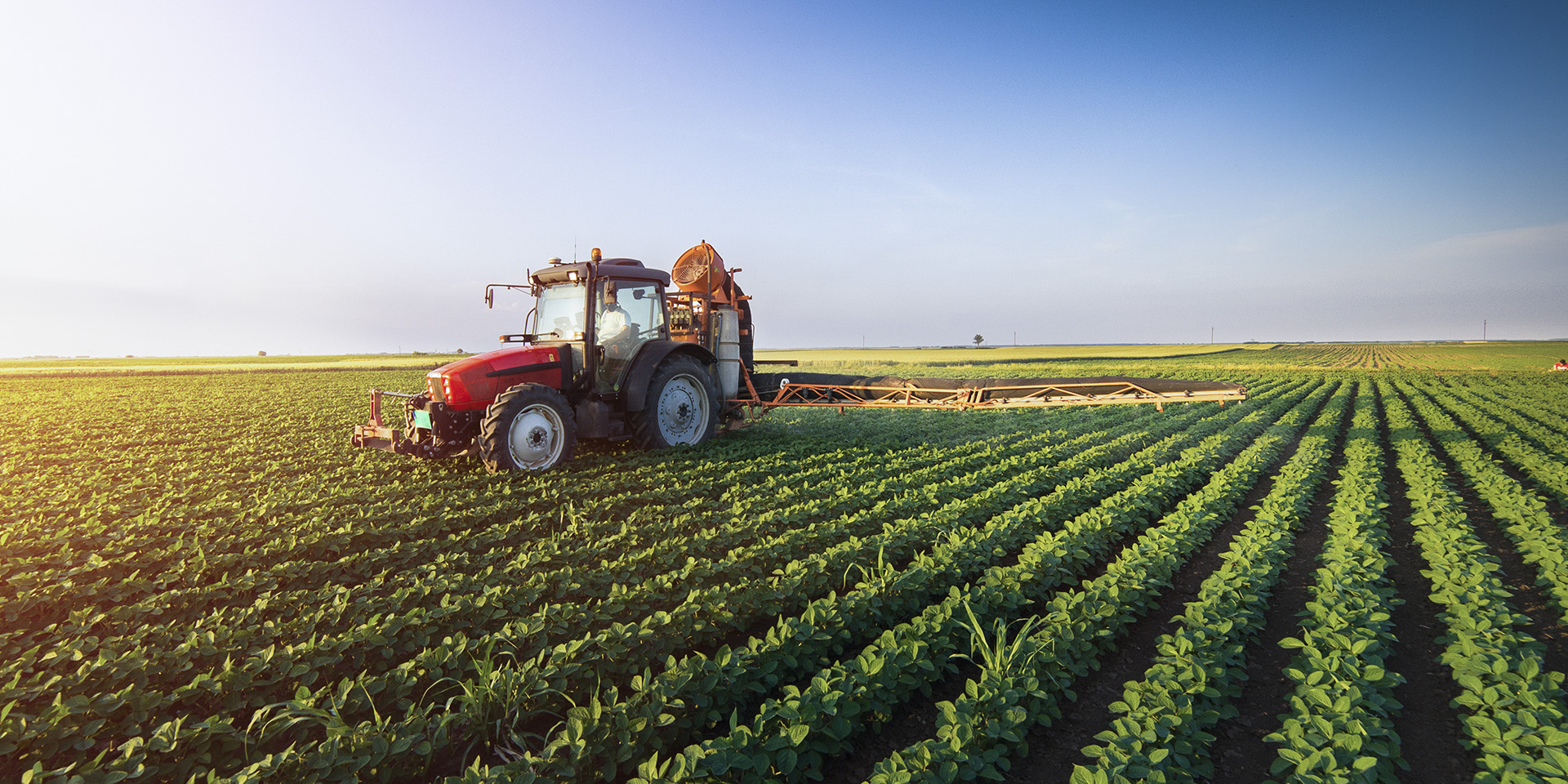Applying IoT in agriculture will manage, produce, and process food with higher quality and productivity than traditional agriculture, to meet the increasing demand for food worldwide.
The opening of the 4.0 industrial revolution started the strong development of technology and its positive impacts on many industries and fields, including the agricultural industry. All changes drive the agricultural industry’s needs to transform and apply technology solutions to the industry to become smart agriculture – digital agriculture. The application of IoT sensors in agriculture will be one of the directions to move toward digital agriculture.
IoT definition and its benefits for agriculture
IoT or Internet of Things is a system of interrelated technological devices, everything is connected to each other based on a common protocol, the Internet. Investment in IoT will continue to increase sharply. The global IoT market is estimated to reach $1,567 billion by 2025, up from $110 billion in 2017, at a compound annual growth rate (CAGR) of 39% from 2017 to 2025 (Figure 1). (1)

A research by Business Insider predicted that by 2023 there would be 12 million agricultural sensor devices installed globally (2). The global smart agriculture market is predicted to reach $15,344 million by the end of 2025, tripling compared to 2016 ($5,098 million) and growing at a CAGR of over 13.09% from 2017 to 2025 (3).

Benefits of IoT for the agricultural industry
IoT shows potential benefits for the agricultural market, this is the reason why IoT will become more and more popular. Specifically, IoT can provide the ability to collect and display data for the entire agricultural production process. Agricultural models applying IoT bring positive results to farmers such as increased productivity, improved quality of agricultural products, cost savings, proactive in production, etc.
IoT sensors collect data related to environmental indicators such as temperature, humidity, light, etc. Through the analysis of these data, farmers can predict which crops and livestock are suitable for forecast conditions. Sensors attached to crops and livestock allow farmers to monitor their quality status remotely, saving time and labor resources.
Applying IoT to agriculture as a foundation for building smarter agriculture, improving the quality of agricultural products, ensuring food hygiene, and creating high value for food products.
Some IoT application cases in agriculture
IoT applications in agriculture support farmers in many work stages. Besides helping to collect data or manage quality for crops and livestock, IoT has the ability to monitor the status of machinery and equipment, helping people to plan the best maintenance plans. Below are some applications of IoT in the agricultural industry.
IoT application in agriculture to help manage crop data
IoT sensors located in fields or farms collect data about the surrounding environmental conditions. The data is updated to the data storage cloud (Cloud) and analyzed so that farmers can monitor these metrics remotely. This analytic usage helps farmers to accurately and optimally allocate the resources needed for the growth and development of crop products.
Greenhouse farming model
One farming model that is being widely applied in the world is greenhouse farming. Installing IoT sensors into the greenhouse cultivation model helps to collect data and adjust environmental indicators such as temperature, soil moisture, water, air, light, etc. stabilize, avoid negative impacts from the environment and ensure that plants have the most suitable conditions for development and growth.
This sensor system will be installed both inside and outside the greenhouse to collect data to balance parameters of solar radiation intensity, rain warning, wind speed, rainfall volume, etc. to maintain the greenhouse always in the desired conditions.
Controlling all environmental data and crop data helps farmers ensure the development and expansion of production for the growing process. Simultaneously, they become proactive and manage information sources more easily. Minimize the frequency of manual measurement of environmental conditions. The metrics are measured and transmitted via farmer’s mobile devices, therefore, they can make quick decisions for the necessary adjustments.

IoT sensors help farmers manage the quality of crops and livestock
In breeding, IoT sensors help farm owners control the location of their livestock, and monitor their activity and health status. These data help farmers to detect diseased ones early so that they can quickly come up with solutions to prevent the spread of disease to the whole herd.
In planting, attaching tracking sensors to each plant helps the manager to promptly grasp the growth status of the plant and overcome problems such as lack of water, nutrients or detecting pathogens. Based on these data, farmers can develop a timely response plan to ensure the quality of agricultural products.
For agricultural products, IoT plays an important role in verifying product quality transparency. Attaching sensors to each product object helps farmers to monitor and collect data from the process of growing and raising livestock, to processing, packaging and sales. The clarity in managing information about product quality until it reaches the users helps to ensure the best product quality and build trust with consumers.
IoT enables farmers to manage more reliably and efficiently crop and livestock quality. The quality of crops and livestock is increasing guaranteed with good management quality to help improve the revenue of agricultural enterprises in particular and boost the country’s economy in general.
Applying IoT to monitor the operating status and plan maintenance for machines
IoT devices collect data from machines to provide analysis, detect machines with abnormal activities, and launch warnings to find problems to fix or plan maintenance. This helps to reduce the risk of machinery breakdown and maintenance in order to increase uptime, improve operational productivity of agribusiness as well as ensure quality and customer satisfaction.
In the past, the maintenance of machines is only at a passive level (replacement, maintenance when the machine has problems), scheduled maintenance (fixed at a certain interval), then by applying IoT, the maintenance of machines is implemented in a more optimal and efficient way.
IoT devices help predict and diagnose the time when machines may fail to replace and maintain machines, avoiding production line interruption. Delays and difficulties in repair can lead to disruption in all subsequent stages, affecting operational performance.
With a large number of machines in business operations, IoT applications help manage machines more efficiently and optimally.
Conclusion
Besides the above applications, IoT can also be applied in some other cases such as tracking the journey of means of transport or monitoring the quality of agricultural products during transportation, managing storage/warehouse conditions for individual products or controlling the entire logistics, etc. It can be seen that the potentials and benefits of IoT in agriculture are huge and are still being exploited, supporting farmers and agribusinesses in management, production, and commerce activities.
In Vietnam, agricultural enterprises have started to apply IoT sensors in their production activities. They saw the potential benefits of IoT in creating incentives to drive operations to be cost savings and operational optimization. Applying IoT in business activities, agribusinesses will create for themselves a sustainable competitive advantage.
References
(1) IoT Analytics. 2018. State of the IoT 2018: Number of IoT devices now at 7B – Market accelerating.
(2) Business Insider Intelligent. 2020. Smart Farming in 2020: How IoT sensors are creating a more efficient precision agriculture industry.
(3) GlobeNewswire. 2018. Global Smart Agriculture Market Will Reach USD 15,344 million by 2025: Zion Market Research.
(4) Statista. 2018. Internet of Things (IoT) active device connections installed base worldwide from 2015 to 2025.





